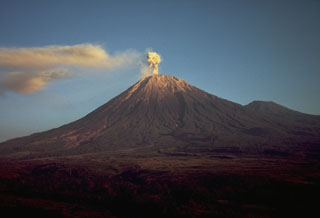Report on Semeru (Indonesia) — 30 December-5 January 2021
Smithsonian Institution / US Geological Survey
Weekly Volcanic Activity Report, 30 December-5 January 2021
Managing Editor: Sally Sennert.
Please cite this report as:
Global Volcanism Program, 2020. Report on Semeru (Indonesia) (Sennert, S, ed.). Weekly Volcanic Activity Report, 30 December-5 January 2021. Smithsonian Institution and US Geological Survey.
Semeru
Indonesia
8.108°S, 112.922°E; summit elev. 3657 m
All times are local (unless otherwise noted)
PVMBG reported that incandescent material ejected 50 m above Semeru’s summit was visible most nights during 30 December-5 January. Cloudy weather often obscured visual observations during the daytime. A pyroclastic flow traveled 3.5 km down the Kobokan drainage on the SE flank on 31 December. Incandescent material from the ends of lava flows descended 300-1,000 m, reaching a maximum distance of 550-1,250 m from the crater during 1-3 January. The Alert Level remained at 2 (on a scale of 1-4), with a general exclusion zone of 1 km and extensions to 4 km in the SSE sector.
According to BNPB, observers at the Gunungsawur Observatory, 12 km SE of Semeru, recorded heavy rain around the volcano on 30 December, resulting in multiple lahars. At 0939 a lahar in the Koboan River drainage on the SE flank was seen and also recorded by the post’s seismic station. A lahar detected at 0950 was followed by an increase in water flow in the Curah Koboan, Rejali Bondeli, and Regoyo watersheds. At 1111 the seismic station recorded a lahar and accompanying pyroclastic flow that traveled 3.5 km down the Curah Koboan drainage. At 1130 lahars in Curah Koboan drainage damaged bamboo stalls owned by a local resident in Sumberwuluh Village (15 km SE).
Geological Summary. Semeru, the highest volcano on Java, and one of its most active, lies at the southern end of a volcanic massif extending north to the Tengger caldera. The steep-sided volcano, also referred to as Mahameru (Great Mountain), rises above coastal plains to the south. Gunung Semeru was constructed south of the overlapping Ajek-ajek and Jambangan calderas. A line of lake-filled maars was constructed along a N-S trend cutting through the summit, and cinder cones and lava domes occupy the eastern and NE flanks. Summit topography is complicated by the shifting of craters from NW to SE. Frequent 19th and 20th century eruptions were dominated by small-to-moderate explosions from the summit crater, with occasional lava flows and larger explosive eruptions accompanied by pyroclastic flows that have reached the lower flanks of the volcano.
Sources: Pusat Vulkanologi dan Mitigasi Bencana Geologi (PVMBG, also known as CVGHM), Badan Nacional Penanggulangan Bencana (BNPB)

